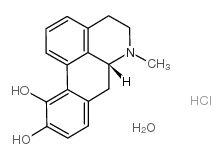阿朴吗啡

阿朴吗啡结构式

|
常用名 | 阿朴吗啡 | 英文名 | R-(-)-Apomorphine |
|---|---|---|---|---|
| CAS号 | 41372-20-7 | 分子量 | 321.79900 | |
| 密度 | 1.299 g/cm3 | 沸点 | 473.4ºC at 760 mmHg | |
| 分子式 | C17H20ClNO3 | 熔点 | 285-287 °C(lit.) | |
| MSDS | 中文版 美版 | 闪点 | 268.8ºC | |
| 符号 |

GHS06 |
信号词 | Danger |
|
Modulation of 5-lipoxygenase in proteotoxicity and Alzheimer's disease.
J. Neurosci. 33(25) , 10512-25, (2013) The accumulation of intracellular β amyloid (Aβ) may be one of the factors leading to neuronal cell death in Alzheimer's disease (AD). Using a pyrazole called CNB-001, which was selected for its ability to reduce intracellular Aβ, we show that the activation ... |
|
|
Activation of serotonin2A receptors in the medial septum-diagonal band of Broca complex enhanced working memory in the hemiparkinsonian rats.
Neuropharmacology 91 , 23-33, (2015) Serotonin2A (5-HT2A) receptors are highly expressed in the medial septum-diagonal band of Broca complex (MS-DB), especially in parvalbumin (PV)-positive neurons linked to hippocampal theta rhythm, which is involved in cognition. Cognitive impairments commonly... |
|
|
Effects of prolonged neuronal nitric oxide synthase inhibition on the development and expression of L-DOPA-induced dyskinesia in 6-OHDA-lesioned rats.
Neuropharmacology 89 , 87-99, (2014) It is well known that nitric oxide (NO) interacts with dopamine (DA) within the striatal circuitry. The anti-dyskinetic properties of NO synthase (NOS) inhibitors demonstrate the importance of NO in L-3,4-dihydroxyphenylalanine (L-DOPA)-induced dyskinesia (LI... |
|
|
Absence of aryl hydrocarbon receptors increases endogenous kynurenic acid levels and protects mouse brain against excitotoxic insult and oxidative stress.
J. Neurosci. Res. 93 , 1423-33, (2015) L-kynurenine (Kyn) is a key element of tryptophan metabolism; it is enzymatically converted by kynurenine aminotransferase II (KAT II) to kynurenic acid (KYNA), which acts as an antagonist to the NMDA receptor-glycine site. Kyn is also an endogenous ligand of... |
|
|
Monoamine receptor agonists, acting preferentially at presynaptic autoreceptors and heteroreceptors, downregulate the cell fate adaptor FADD in rat brain cortex.
Neuropharmacology 89 , 204-14, (2014) FADD is a crucial adaptor of death receptors that can engage apoptosis or survival actions (e.g. neuroplasticity) through its phosphorylated form (p-FADD). Although FADD was shown to participate in receptor mechanisms related to drugs of abuse, little is know... |
|
|
Pramipexole reduces parkinsonian tremor induced by pilocarpine infusion in the rat striatum.
Pharmacol. Biochem. Behav. 131 , 1-5, (2015) Pramipexole is widely prescribed for the treatment of Parkinson's disease. This dopamine (DA) receptor agonist has a higher affinity for D3 over D2 receptors. We compared the effect of pramipexole to apomorphine, a non-specific DA receptor agonist, on the sup... |
|
|
Quantitative high-throughput identification of drugs as modulators of human constitutive androstane receptor.
Sci. Rep. 5 , 10405, (2015) The constitutive androstane receptor (CAR, NR1I3) plays a key role in governing the transcription of numerous hepatic genes that involve xenobiotic metabolism/clearance, energy homeostasis, and cell proliferation. Thus, identification of novel human CAR (hCAR... |
|
|
Serotonin₆ receptors in the dorsal hippocampus regulate depressive-like behaviors in unilateral 6-hydroxydopamine-lesioned Parkinson's rats.
Neuropharmacology 95 , 290-8, (2015) Preclinical studies indicate both activation and blockade of serotonin6 (5-HT6) receptors may produce antidepressant-like effects. Depression is a common symptom in Parkinson's disease (PD); however, its pathophysiology is unclear. Here we examined whether 5-... |
|
|
Selective deletion of GRK2 alters psychostimulant-induced behaviors and dopamine neurotransmission.
Neuropsychopharmacology 39(10) , 2450-62, (2014) GRK2 is a G protein-coupled receptor kinase (GRK) that is broadly expressed and is known to regulate diverse types of receptors. GRK2 null animals exhibit embryonic lethality due to a severe developmental heart defect, which has precluded the study of this ki... |
|
|
Differential substitution for the discriminative stimulus effects of 3,4-methylenedioxymethamphetamine and methylphenidate in rats.
J. Pharmacol. Exp. Ther. 350(2) , 403-11, (2014) Previous studies have demonstrated that methylphenidate, MDMA (3,4-methylenedioxymethamphetamine), and other psychostimulants exert stimulant-like subjective effects in humans. Furthermore, MDMA and methylphenidate substitute for the discriminative stimulus e... |